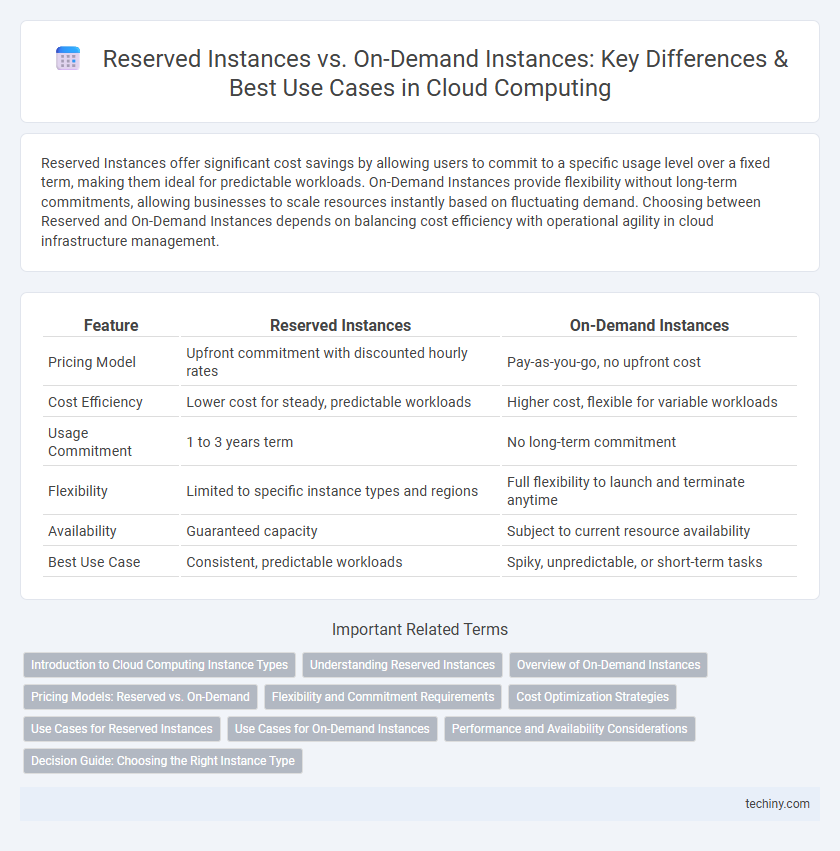Reserved Instances offer significant cost savings by allowing users to commit to a specific usage level over a fixed term, making them ideal for predictable workloads. On-Demand Instances provide flexibility without long-term commitments, allowing businesses to scale resources instantly based on fluctuating demand. Choosing between Reserved and On-Demand Instances depends on balancing cost efficiency with operational agility in cloud infrastructure management.
Table of Comparison
| Feature | Reserved Instances | On-Demand Instances |
|---|---|---|
| Pricing Model | Upfront commitment with discounted hourly rates | Pay-as-you-go, no upfront cost |
| Cost Efficiency | Lower cost for steady, predictable workloads | Higher cost, flexible for variable workloads |
| Usage Commitment | 1 to 3 years term | No long-term commitment |
| Flexibility | Limited to specific instance types and regions | Full flexibility to launch and terminate anytime |
| Availability | Guaranteed capacity | Subject to current resource availability |
| Best Use Case | Consistent, predictable workloads | Spiky, unpredictable, or short-term tasks |
Introduction to Cloud Computing Instance Types
Reserved Instances offer cost savings by allowing users to commit to a fixed term, typically one to three years, providing guaranteed capacity and a lower hourly rate compared to On-Demand Instances. On-Demand Instances deliver flexibility with pay-as-you-go pricing, enabling users to scale resources instantly without upfront commitments. Choosing between these instance types depends on workload predictability, budget preferences, and resource management strategies in cloud computing environments.
Understanding Reserved Instances
Reserved Instances provide significant cost savings by committing to a specific instance type and region over a one- or three-year term, making them ideal for predictable, steady-state workloads in cloud computing. These instances offer capacity reservation, ensuring availability during peak demand periods, and can be purchased with partial upfront, all upfront, or no upfront payment options to suit different budget preferences. Understanding Reserved Instances helps organizations optimize cloud expenses while maintaining performance and scalability for consistent applications.
Overview of On-Demand Instances
On-Demand Instances provide flexible, pay-as-you-go pricing for cloud computing resources, allowing users to scale capacity without long-term commitments. These instances are ideal for unpredictable workloads and short-term applications, offering immediate availability and billing by the second or hour. On-Demand pricing ensures cost control while maintaining high accessibility and operational agility in cloud environments such as AWS, Azure, and Google Cloud.
Pricing Models: Reserved vs. On-Demand
Reserved Instances offer significantly lower hourly rates in exchange for a commitment to use cloud resources over a one- or three-year term, providing predictable and reduced costs for steady-state workloads. On-Demand Instances provide flexible, pay-as-you-go pricing with no upfront commitment, suitable for variable or unpredictable workloads but at a higher cost per hour. Choosing between Reserved and On-Demand pricing models depends on workload stability, budget predictability, and cost optimization strategies in cloud computing environments.
Flexibility and Commitment Requirements
Reserved Instances require a long-term commitment, typically one to three years, offering significant cost savings in exchange for reduced flexibility. On-Demand Instances provide maximum flexibility with no upfront commitment, allowing users to scale computing resources instantly based on fluctuating workloads. Organizations must balance cost efficiency with operational agility when choosing between Reserved and On-Demand Instances.
Cost Optimization Strategies
Reserved Instances offer significant cost savings by committing to a fixed usage term, often providing discounts up to 75% compared to On-Demand Instances, which are billed per hour or second without long-term commitment. On-Demand Instances provide flexibility for unpredictable workloads but at a higher cost, making them ideal for short-term or variable usage. Leveraging Reserved Instances for steady-state workloads combined with On-Demand Instances for scaling and bursts optimizes overall cloud spend effectively.
Use Cases for Reserved Instances
Reserved Instances in cloud computing provide significant cost savings for steady-state workloads by offering discounted prices in exchange for a commitment to use specific instance types over one to three years. They are ideal for applications with predictable and consistent usage patterns, such as databases, enterprise applications, and long-term development environments. Reserved Instances maximize budget efficiency while ensuring reliable and continuous performance for critical services.
Use Cases for On-Demand Instances
On-Demand Instances in cloud computing provide flexibility for unpredictable workloads, making them ideal for applications with variable or short-term usage patterns. They suit development and testing environments where capacity needs fluctuate frequently, and for new projects requiring instant access to compute resources without long-term commitment. On-Demand Instances also support burst workloads and scaling during peak traffic periods, ensuring responsiveness without upfront costs.
Performance and Availability Considerations
Reserved Instances offer predictable performance with guaranteed capacity, making them ideal for steady workloads requiring consistent availability. On-Demand Instances provide flexible scaling and immediate access to compute resources, optimizing availability during variable or unpredictable traffic spikes. Performance in Reserved Instances benefits from reserved capacity, while On-Demand Instances prioritize agility without long-term commitments.
Decision Guide: Choosing the Right Instance Type
When selecting between Reserved Instances and On-Demand Instances in cloud computing, consider workload consistency and budget predictability as key factors. Reserved Instances provide significant cost savings for steady-state workloads with long-term commitments, while On-Demand Instances offer flexibility and scalability for variable or unpredictable usage patterns. Analyzing usage data and forecasting demand helps optimize cloud costs and performance by aligning instance purchasing decisions with business needs.
Reserved Instances vs On-Demand Instances Infographic

 techiny.com
techiny.com